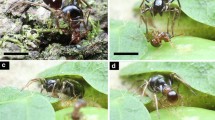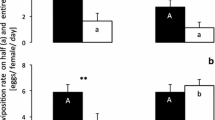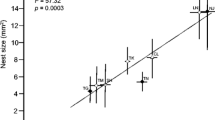Abstract
Four spider species and the predacious mitePhytoseiulus persimilis (Athias-Henriot) were examined in the laboratory for their capacity to feed on the carmine spider mite,Tetranychus cinnabarinus (Boisduval). The adult females ofChiracanthium mildei L. Koch showed the highest capacity for feeding onT. cinnabarinus (27.5 mites/day) and differed significantly from all other spider species, including the immatureC. mildei which consumed an average of 18.9 mites/day — nearly equal to that of the Oxyopidae species (16.8 mites/day). The salticid (10.1 mites/day) and theridiid (9.5 mites/day) spider species had the lowest capacity, which was nearly equal to that of the predacious miteP. persimilis (11.3 mites/day). Results indicate that spiders play an important role as mite predators.
Similar content being viewed by others
References
Avidov, Z. and Harpaz, I. (1969) Plant Pests of Israel. Israel Universities Press, Jerusalem.
Butcher, M.R., Penman, D.R. and Scott, R.R. (1988) Field predation of twospotted spider mite in a New Zealand strawberry crop.Entomophaga 33:173–183.
Chant, D.A. (1956) Predacious spiders in orchards in southeastern England.J. Hortic. Sci. 31:35–46.
Coates, T.J.D. (1974) The influence of some natural enemies and pesticides on various populations ofTetranychus cinnabarinus (Boisduval),T. lombardinii Baker & Pritchard andT. ludeni Zacher (Acari: Tetranychidae) with aspects of their biologies.S. Afr. Dep. Agric. Tech. Serv. Entomol. Mem. 42:1–40.
Dippenaar-Schoeman, A.S. (1976) An Ecological Study of a Spider Population in Strawberries with Special Reference to the Role ofPardosa crassipalpis Purcell (Araneae: Lycosidae) in the Control ofTetranychus cinnabarinus (Boisduval). M.Sc. thesis, Rand Afrikaans Univ., Johannesburg, South Africa.
Hukusima, S. (1961) Studies on the insect association in crop fields. XXI. Notes on spiders in apple orchards.Jpn. J. Appl. Entomol. Zool. 5:270–272.
Mansour, F. (1987) Spiders in sprayed and unsprayed cotton fields in Israel, their interactions with cotton pests and their importance as predators of the Egyptian cotton leaf worm,Spodoptera littoralis.Phytoparasitica 15:31–41.
Mansour, F.A. and Plaut, H.N. (1979) The effectiveness of various acaricides against resistant and susceptible carmine spider mites.Phytoparasitica 7:185–193.
Mansour, F., Rosen, D. and Shulov, A. (1980) Biology of the spiderChiracanthium mildei (Arachnida: Clubionidae).Entomophaga 25:237–248.
Mansour, F., Rosen, D. and Shulov, A. (1980) A survey of spider populations (Araneae) in sprayed and unsprayed apple orchards in Israel and their ability to feed on larvae ofSpodoptera littoralis (Boisd.).Acta Oecol. Oecol. Appl. 1:189–197.
Mansour, F., Rosen, D., Shulov, A. and Plaut, H.N. (1980) Evaluation of spiders as biological control agents ofSpodoptera littoralis (Boisd.) larvae on apple in Israel.Acta Oecol. Oecol. Appl. 1:225–232.
Mansour, F. and Whitcomb, H.W. (1986) The spiders of a citrus grove in Israel and their role as biocontrol agents ofCeroplastes floridensis.Entomophaga 31:269–276.
Mansour, F., Wysoki, M. and Whitcomb, H.W. (1985) Spiders inhabiting avocado orchards and their role as natural enemies ofBoarmia selenaria Schiff. (Lepidoptera: Geometridae) larvae in Israel.Acta Oecol. Oecol. Appl. 6:315–321.
McMurtry, J.A., Huffaker, C.B. and van de Vrie, M. (1970) Ecology of tetranychid mites and their natural enemies: a review. I. Tetranychid enemies, their biological characteristics and the impact of spray practices.Hilgardia 40:331–390.
McMurtry, J.A. and Johnson, A.G. (1966) An ecological study of the spider miteOligonychus punicae (Hirst) and its natural enemies.Hilgardia 37:363–402.
Parent, B.J.P.H. (1973) Natural population densities of the European red mite on apple in Quebec.Environ. Entomol. 2: 1064–1068.
Putman, W.L. (1967) Prevalence of spiders and their importance as predators in Ontario peach orchards.Can. Entomol. 99:160–170.
Putman, W.L. and Herne, D.C. (1966) The role of predators and other biotic factors in regulating the population density of phytophagous mites in Ontario peach orchards.Can. Entomol. 98:808–820.
Riechert, E.S. and Lockley, T. (1984) Spiders as biological control agents.Annu. Rev. Entomol. 29:288–320.
Author information
Authors and Affiliations
Rights and permissions
About this article
Cite this article
Mansour, F., Bernstein, E. & Abo-Moch, F. The potential of spiders of different taxa and a predacious mite to feed on the carmine spider mite — a laboratory study. Phytoparasitica 23, 217–221 (1995). https://doi.org/10.1007/BF02981385
Received:
Issue Date:
DOI: https://doi.org/10.1007/BF02981385




